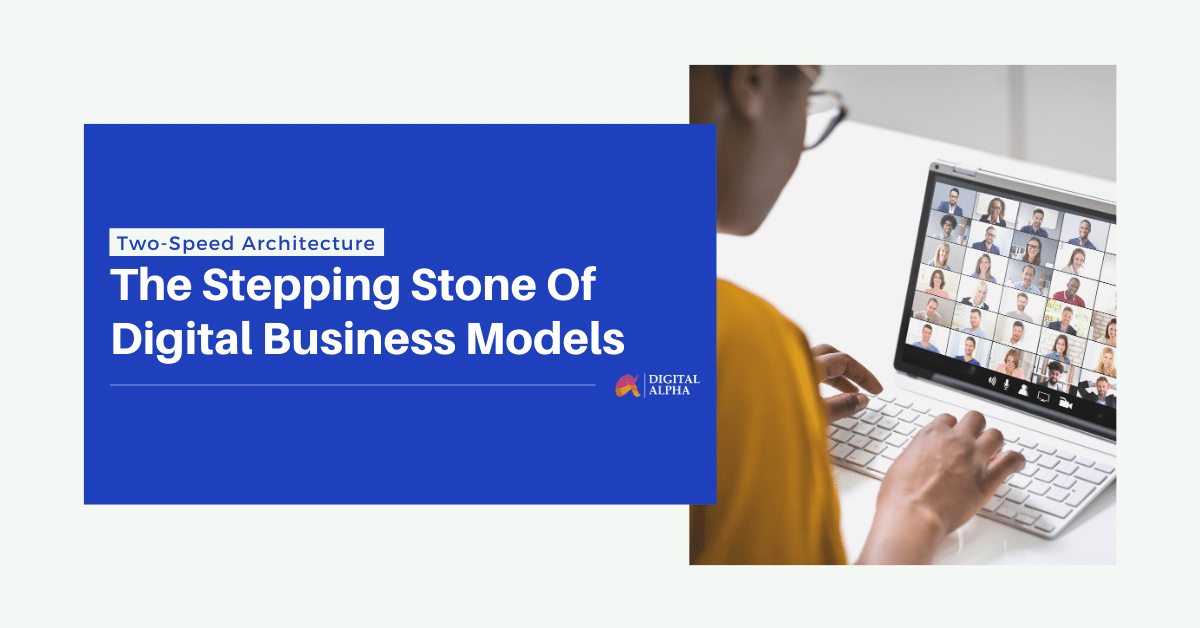What is the Two-Speed IT-Architecture?
- The Two-Step architecture is a digital business model that implies an agile customer-centric front end, running along a slow-speed, business-focused legacy back end.
- E-commerce, social networks, and OTT platforms are setting up new benchmarks for efficiency, speed, user-friendliness that consumers are expecting in other sectors like banking, telecommunication, etc. Companies born in the digital age give consumers what they want, but many incumbent companies struggle to meet business needs.
Things to keep in mind while digitizing a company
- Business Model: The digital business model lets us create digital services and products. Companies need to become skilled at digital-product innovation that meet growing business needs.
- Dynamic Channeling: Customer-facing companies need to create a smooth inter-channel experience so that the customer can move effortlessly from one channel to another.
- Automation: Focusing and improving on digitizing and automating business processes enables quicker response to the business needs and at the same time helps to cut down on unnecessary operating costs.
- Analytics: Use of big data and advanced analytics to get better insights into the business and patterns. Business decision-making can further improve with the use of this data.
Therefore the two-speed IT architecture helps companies to improve their insights and decision-making capabilities at a fast pace and at the same time decouples the legacy system at a slower pace.
Building blocks of Digital Enterprise Architecture
- Modular and Stable: This implies a fast-paced user-centric front end running alongside a slow-speed business-focused legacy back end. The user front should be dynamic and modular, allowing the rapid deployment of new services. In contrast, design the legacy backend for high-quality data management, cyber-security, and stability.
- Decentralized: Microservices define only a small amount of functionality and must be deployable as quickly as possible. Promote cross-platform development instead of using a single development framework.
- Easy Process Configuration: The business user themselves should be able to change automated processes i.e. they should be able to eliminate unnecessary steps without the help of a developer.
- Real-time Data Analytics: The ability to analyze data in real-time, can make analytics an integral part of operational processes. This analytics aids in studying and understanding business patterns and can enhance decision-making.
- Zero Downtime: Long maintenance windows are no longer an option There should be fallback mechanisms for daily operations to provide a seamless experience to the user in case any system fails. Issues related to a single service should not affect other services.
- Automated Scaling: Workload increases with time and becomes hard to predict in the digital business world. Balance the load across various cloud environments with efficient optimization, so that if one of the environments experiences an outage, the others can compensate for the load.
- Cybersecurity: Cybersecurity must be an integral part of the overall service/product, as the company has valuable data to protect, making it prone to attackers. From the company’s business strategy perspective, it’s crucial because hackers can exploit these strategies.
Challenges faced by Enterprise Architecture
- Product line Management: Companies tend to keep their product line in silos. This hinders getting a comprehensive view of the customer.
- Channel Management: Most users face difficulty using multiple channels because most of these channels are managed and tracked independently. Therefore, it becomes difficult for a user to switch from one channel to another.
- System Integration: Inefficient system integration and slow database access time can prevent the customer from enjoying a seamless user experience.
- Analytics and Process Flow: Manual steps in these processes present major obstacles in both automation and analytics of the overall process.
Implementing Two Speed Architecture
Traditional companies don’t have the luxury of starting from scratch like these new digital companies. They need to build an architecture designed for the digital world but on a legacy foundation. It is important to realize that digital transformation is a continuous process of delivering new functionality rather than building business models sequentially over the long run.
Digital Transformation focuses on the following aspects
- Heterogeneous architecture: Design a hybrid architecture that scales and makes the platform resilient while coexisting alongside other systems optimized for better user experience.
- Agile delivery: Ditch the waterfall model. This requires proper segregation of platforms into domains managed for efficient delivery or for transactional integrity.
- Integration and Transformation: In a digital enterprise integration between business and IT is a must. Transformation means building a new organization and governance model in parallel with new technology. During the transformation, establish this partnership.
- Parallel streams of implementation: The implementation plan runs in 3 parallel streams. The digital transformation stream builds new functionality, supported by the result of a short-term optimization stream. The third stream is the architecture stream to develop short-term measures and to create a sustainable IT infrastructure.
For most traditional user-facing companies, building a new digital IT architecture that runs alongside legacy systems makes it possible to compete with digital natives.
